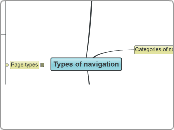Types of navigation
Several aspects to distinguish them
The type of content a mechanism accesses
Behavior of the navigational links and transition to the next page
The tasks and modes of seeking the mechanism supports
Visual treatment of navigational options
The position of a navigation on a page
Categories of navigation
Structural navigation
Main navigation
Answers important questions users may have.
Aids in orientation.
Allows people to switch topics.
Helps visitors to remind where they are in the site.
Gives shape to a site.
Determining factors
The size of the site
User behavior and needs
Stakeholder objectives
Workflows that can't be interrupted
Example of main navigation
Local navigation
Common arrangements with main navigation
Inverted-L
Horizontal
Embedded vertical
Example of local navigation
Associative navigation
Contextual navigation
Embedded navigation
Related links
Example of contextual navigation
Adaptive navigation
Based on user behavior
Example of adaptive navigation
Boxes and Arrows
Quick links
To a related sub-site
To an online shop area
To a new web site
Dynamic menu
Example of quick links
Footer navigation
Acces to supplementary information
Example of footer navigation
Utility navigation
Assistance in the use of the site
Types
Extra-site navigation
Toolboxes
Linked logos
Language selectors
Country selectors
Internal page navigation
Example of utility navigation
Navigation issues
Browsers don't distinguish between internal page links and external links.
Internal links may or may not be shown as visited links.
All sections of a longer page may be included in jump links.
Internal links at the top of pages take up valuable screen real estate.
Sometimes a sitewide decision is made to include "back to Top" links on all pages.
If the last section of content is short, an internal link to it at the top may not scroll to the proper position.
Page types
Navigational pages
Home page
Landing pages
Gallery pages
Search result pages
Content pages
Product pages
Typical elements to product pages
Product pictures
Product descriptions
Further details
Related products
Functional elements
Add to a shopping cart or purchase
Save to a wish list
View larger images or zoom in
Change size or color
Email this page
Functional pages
Search forms
Standard search
Web applications
Page length
Influential factors
Screen size is problematic because there is no single screen size model.
Content has not the same impact broken up into multiple pages.
People don't like to read too much online
It may not be efficient to download pages for small bits of content.
The page type is also a key factor.
